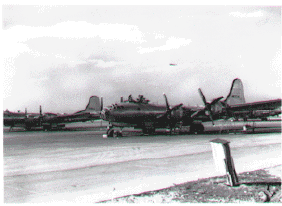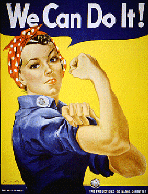Mid & Late 20th Century: 1941 to the Present
- World War II
- Kansas After World War II
- Late 20th Century Political & Social Changes
- Culture
& Progress in Modern Kansas

World War II
When we think about the enormous investment of lives and energy made by the
United States in the
Second World War,
it is difficult for us to imagine that many Americans were not enthusiastic
about our entering the war. Some believed, as with the First World War, that it
was a European War.
Harry
Woodring, a former Democratic Governor of Kansas and President
Roosevelt's Secretary of War, was dropped from the cabinet because he disagreed
with President Roosevelt's policies regarding the war.
To drum up support for the war, the Committee to Defend America by Aiding the
Allies was formed in 1940, with William Allen White as its chairman. Even though
many did not wish to commit to war, it was good for business in Kansas. The
Reconstruction Finance Corporation helped pay for expansion of the Stearman
Division of the Boeing Aircraft Corporation. Boeing made parts for the
B-17 Flying Fortress bomber in Wichita. Beech Aircraft received a
multi-million dollar contract to make training planes for the military. There
was also expansion of Fort Leavenworth and Fort Riley for training troops. It is
estimated that fifty million dollars came into the Kansas economy as a result of
defense-related spending during World War II.
When the Japanese attacked Pearl Harbor on December 7, 1941,
most Kansans united behind the war effort. One of the longest lasting
economic effects of the war was on the aircraft industry in Wichita. Cessna
Aircraft manufactured planes for the army. The
B-29 Superfortress was manufactured in Wichita. Pilots were
trained at Salina. Some of the landing craft used in the D-day invasion in
France in 1944 were manufactured in the Fairfax district of Kansas City.
Kansas agricultural products played a major role in supporting the war
effort, but farm labor was scarce because of the large numbers of young men
in the service. Farm labor was supplemented by students, women, men with
draft exemptions and, in some cases, German prisoners of war who were being
held at Concordia, Salina, and Fort Riley.
New industries gave employment
opportunities for laborers. As new factories opened, laborers moved to the
cities for jobs. Women also entered the workforce in large numbers during
the war. "Rosie
the Riveter" was the nickname given to women who worked in defense
industries. Because so many men went to war, the women needed to take jobs
that had previously been performed by men. Had women not worked
patriotically for the country, the United States might have lost the war.
|

B-29's being serviced at the Smoky Hill Army Air Field in
Salina during World War II
(Photo courtesy of the Kansas State Historical
Society)
|

Poster representing
Rosie the
Riveter
|
Approximately 3,500 Kansans were killed in action during World War II. Most
notable among Kansans serving in the war was Dwight D. Eisenhower. "Ike" was
born in Texas but grew up in Abilene, which is the sight of the
Eisenhower
Presidential Library. He was the supreme commander of the allied forces for the D-day
invasion that ended the war in Europe.
The atomic bombs dropped on Japan ended the war in the Pacific. Kansans
living today may have been indirectly affected by the project that created the
atom bomb. In the early stages of development, bombs were routinely exploded in
the atmosphere in the Southwest, and Kansans, along with millions of others
living in the Midwest, were exposed to radioactive fallout which
drifted to the east. The exposure has recently been linked to increased rates of
cancer in individuals in some areas.

Additional Resources

Study Guide Questions
- How did World War II benefit Kansans economically?
- How did William Allen White help the war effort?
- How did the aircraft industry in Kansas contribute to the was effort?
- How did the farmer's supplement their labor force during the war?
- What was the role of Dwight Eisenhower in World War II?
Back to Top
![]()
![]()